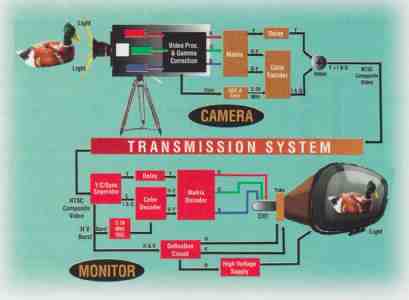DVD’s ability to store and reproduce video in component form is good news for videophiles. But just what is component video?
If you’ve been paging through this issue up to this point, you’ve seen the phrase “component video” repeated over and over again in the many articles on DVD. Obviously, we feel very strongly that it is one of DVD’s most important attributes. But just exactly what is component video? Why is it better than standard, composite video? And doesn’t Laserdisc already have it? For the answer to these and other component- video questions, read on.
Color video from, say, a video camera, begins as three channels of information: red, green, and blue (RGB) (see Fig. 1). During processing and editing, the RGB signal is normally converted into another, more robust format. Called component video, the new format also has three channels: Y, Red-Y, and Blue-Y. Y represents the black and white (or more properly, “luminance”) information, which is itself made up of a fixed ratio of red, green, and blue. (The actual formula is Y = 0.3R + 0.59G + 0.11B.)
Before we can even think about broadcasting this information, the three separate signals must be squeezed into a single, limited-bandwidth channel. To do this, some of the color information (contained in the R-Y and B-Y “color difference” signals) must be discarded—a sort of analog data compression. (Those who complain about the digital data compression needed for DVD would do well to note that the “uncompressed” analog video in all consumer formats has always limited data according to known information about human visual perception.)
Having had their bandwidth and amplitude reduced, the R-Y and B-Y color-difference signals—now known as “I” and “Q”—are modulated 90 degrees out of phase with each other onto 3.58 MHz color sub-carriers, and added back into the Y (black and white) signal.
What we wind up with from all of this rigmarole is a single channel of information—a composite video signal. Add sound, and it is ready for broadcast or storage on a consumer video medium, such as a laserdisc or videocassette. (Yes, the signal on what is arguably the best current consumer video format—laser- disc—is stored in composite form.)
Unfortunately, the processing required to encode and store a composite signal and subsequently translate it back into RGB and Y information (a function that must be performed by the NTSC decoder circuit inside a television before an image can be displayed) results in signal degradation. This has so long been part and parcel of all “home video” for mats that we have come to expect such degradation as normal. Now, it doesn’t have to be.
DVD retains and stores video information in the original component form. No modulation or subcarriers are involved. The RGB and Y information can be easily retrieved from the Y, R-Y, and B-Y signals stored on the disc by simple mathematical manipulation.
However, to make use of this advance, your DVD player must be equipped with a component-video output, and your TV monitor must have a component-video input. But since 990/s of the TVs in the world are not so equipped, all DVD players will also provide a standard composite output. Many DVD players will also provide an S-video output, as well, but this is not component video. With S-video, there are two channels of information—Y (luminance) and C (color, or “chrominance”)—not three.
Using composite video at the play back end with DVD will throw away an important advantage of the format. Not only that, but to provide composite video output, your DVD player must create it out of the component video stored on the disc. It is unlikely that the coding and modulating circuitry built into DVD players will be of the highest quality, and even if they are, you still have the added step of decoding the player-generated composite signal in your standard television.

FIG. 1:The RGB signal from the camera is converted to component form, then
manipulated to create a composite video signal. The process is reversed inside
the video display.
== == ==
[adapted from 1996 Stereophile Guide to Home Theater article]